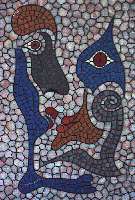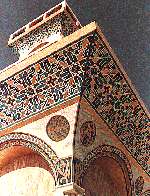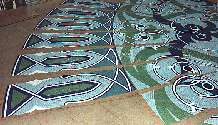
 |

A
VISIT TO DEMOCO
|
 The Kiss by Paul Bull |
Brian Bull's firm is at Chipping Sodbury, a pleasant Cotswold town not far from Bristol, the city that made him a mosaicist. It seems that since Roman times the Italian province of Friuli (where Spilimbergo is now the home of the Dona smalti firm) has been a centre for mosaic making. And it came to pass that a man named Maddeleina went forth from Friuli to make mosaics for the Czar's Hermitage in Russia, taking his seven sons with him. Those were the days. They next worked in Germany, then helped with some of the mosaics in Westminster Cathedral, and eventually settled in Bristol, on land owned by the Bull family. It was sons Beppi and Peter who taught Brian the art of mosaic. Born in 1933 Brian painted from early childhood, but couldn't afford to go to art school; so at fourteen he joined his father as an apprentice floor layer - tiling et al. Seeing the Auguste Wagner mosaics in Berlin's Olympic Stadium in 1953, while on National Service, made him decide to be a mosaicist.
 |
|
Mosaic for |
In the fifties he worked in England for various property developers, like the delicously named Erno Goldfinger. When demand fell off in this country, he worked abroad, mainly in the Middle East, producing mosaics for mosques, hotels and palaces. He has prospered remarkably - making some 2000 murals between 1962 and 1976 (employing up to twenty mosaicists at a time), and some 300 domes (inside and out) to date. He has done 32 television programmes on mosaic, and written a book (Mosaics, published by Triton, 1976) now out of print but well worth trying to get hold of. It has an invaluable chapter on fixing mosaics, with a wonderful story about how not to do it. Brian was working on an outside wall near Holloway Prison, and during a tea-break while it rained watched a van draw up opposite. A chap started unloading a large reverse mosaic sent from Venice. Having plastered wettish cement all over his wall, this chap started putting up the sections, beginning - correctly - at the top. And after ten minutes the first of his sections started slipping off... Seconds later four men were desperately trying to keep the damn things on the wall. Hopeless. Finally there was just a pile of tesserae at the foot of the wall... If you want to learn how you should do it, read the book.
Brian's three children are also in the business, having started as toddler mosaicists. They are all superb mosaic artists in their own right - Paul, for example, has exhibited at the Royal West of England Academy in Bristol. While he shares the designing and geometry with his father, Tina and Mark run the studio and oversee the making of the mosaics. Mark also travels abroad to supervise the installation of the more complex domes, etc. The firm has had a five-year apprentice scheme since 1974.
 |
|
A
dome mosaic on the studio floor |
Working in reverse, Democo can make around 1000 square feet a month with the current team of eight, depending on the complexity of the design and the proportion of opus musivum. For instance, they did a 900 square foot curved Egyptian scene, complete with camels, flamingos and palm trees, in 32 days. On site a two-man team (one skilled, one not) can lay 5 to 10 metres a day. Working on a large scale and abroad, Brian stresses that the initial survey is crucial. Then there is the geometry. Imagine the problems involved in calculating the templates for a complex design for an onion-shaped Islamic dome, given that those templates have to be laid out flat in the studio at home. The photograph gives a hint as to how it's done. There were 144 separate pieces for that dome. They once did 42 domes in six weeks, each one a different shape and a different design. I asked Paul if he had ever tried using a state-of-the-art computer for the geometry; he had, but there was an error of 5 cms. Too much. So he does it all himself.
Trained as he was by the sons of Friuli, Brian naturally feels that he is in a real sense a direct descendent of the Roman and Byzantine mosaicists; and I was fascinated to learn that he too is convinced that they did use the reverse method. He reckons the figures were made off-site, installed with a double layer of tesserae around them, and then the background was done direct. So we have the practitioners, Brian Bull and Chris Smith of Art Pavements, in direct opposition to the academics, who think the old mosaicists never used the reverse method. To be continued.
And as a change from making large-scale mosaics Brian paints - miniature enamels.
You can get in touch with Democo at Unit 5, Chipping Edge Estate, Hatters Lane, CHIPPING SODBURY, Avon BS17 6AA. Tel: 0454 311353, Fax: 0454 323383.
All
content is copyright of © Mosaic Matters and its contributors.
All rights reserved
Mosaic
Matters is:
Editor: Paul Bentley
Web Manager/Designer: Andy Mitchell
